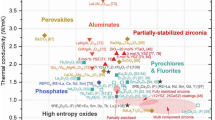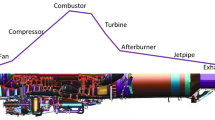Abstract
The automotive industry has traditionally used ceramic honeycomb substrates as catalyst carriers. The long-term durability of a passenger car’s converter is assessed by examining the thermal stresses resulting from the temperature variations experienced under various driving conditions. These thermal stresses constitute the majority of the total stress that the ceramic catalyst substrate experiences while in service. The radial and axial temperature distributions were measured, and the thermal stress was calculated by using the thermal expansion coefficient according to the measured temperature. The threshold stress was determined from the fatigue constant, the required lifetime and the duration of the short term strength tests. The radial temperature variation was higher than the axial temperature variation, and the axial stress was higher than the radial stress because the thermal stress is dependent on the elastic modulus. The radial and axial stresses exist below the threshold thermal stress over the entire engine speed range.
Similar content being viewed by others
References
M. Rempei, Introduction to environment technology in automobile, Grand-Prix Publication, Tokyo (2002) 40–68.
T. Shamim, H. Shen, S. Sengupta, S. Son and A. A. Adamczyk, A comprehensive model to predict three-way catalytic converter performance, ASME J Eng Gas Turbines Power, 124(2) (2002) 421–428.
G. N. Pontikakis, G. S. Konstantas and A. M. Stamatelos, Three-way catalytic converter modeling as a modern engineering design tool, ASME J Eng Gas Turbines Power, 126(4) (2004) 906–923.
D. N. Tsinoglou and G. C. Koltsakis, Influence of pulsating flow on close-coupled catalyst performance, ASME J Eng Gas Turbines Power, 127(3) (2005) 676–682.
E. M. R. Arantes and M. A. F. Medeiros, Optimization of the flow in the catalytic converter of internal combustion engines by means of screens, ASME J Eng Gas Turbines Power, 130(5) (2008) 054504:1–5.
G. N. Coppage and S. R. Bell, Use of an electrically heated catalyst to reduce cold-start emissions in a Bi-fuel spark ignited engine, ASME J Eng Gas Turbines Power, 123(1) (2001) 125–131.
S. H. Baek, S. S. Cho, S. G. Shin and W. S. Joo, Size effect on the modulus of rupture in automotive ceramic monolithic substrate using optimization and response surface method, Trans of the KSME(A) (in Korean), 30(11) (2006) 1392–1400.
J. D. Helfinstine, Adding static and dynamic fatigue effects directly to the Weibull distribution, J Am Ceram Soc, 63(1–2) (1980) 113.
S. T. Gulati, Long-term durability of ceramic honeycombs for automotive emissions control, SAE paper (1985) No. 850130.
D. W. Lee and S. S. Cho, Premature failure prevention of three-way catalyst substrate using DOE, Trans of the KSPE (in Korean), 27(7) (2010) 101–108.
S. H. Baek and S. S. Cho, Comparison of experimental and numerical analysis for durability design criteria in ceramic catalyst substrate, Trans of the KSPE (in Korean), 27(9) (2010) 58–66.
Z. P. Bažant, Y. Zhou, D. Novák and I. M. Daniel, Size effect on flexural strength of fiber-composite laminates, ASME J Eng Mater Technology, 126(1) (2004) 29–37.
S. T. Gulati, Thermal stresses in ceramic wall flow diesel filters, SAE Paper (1983) No. 830079.
S. T. Gulati, L. E. Hampton and D. W. Lambert, Thermal shock resistance of advanced ceramic catalysts for closecoupled application, SAE Paper (2002) No. 2002-01-0738.
R. J. Clarkson, S. F. Benjamin, T. S. Jasper and N. S. Girls, An integrated computational model for the optimisation of monolith catalytic converters, SAE Paper (1993) No. 931071.
J. D. Helfinstine and S. T. Gulati, High temperature fatigue in ceramic honeycomb catalyst supports, SAE Paper (1985) No. 852100.
S. T. Gulati, B. Williamson, J. Nunan and K. Anderson, Fatigue and performance data for advanced thin wall ceramic catalysts, SAE Tech Paper (1998) No. 980670.
Author information
Authors and Affiliations
Corresponding author
Additional information
This paper was recommended for publication in revised form by Associate Editor Yong-Tae Kim
Seok Heum Baek received his B.S. in Mechanical Engineering from Dong-A University, Korea, in 2001. He then went on to receive his M.S. and Ph.D degrees from Dong-A University, Korea, in 2003 and 2010, respectively. Dr. Baek is currently a BK21 Post-Doctoral Fellow at the School of Mechanical Engineering at Dong-A University in Busan, Korea. His research interests cover the area of metamodeling, multidisciplinary modeling and optimization methods, and fatigue fracture analysis.
Seok Swoo Cho received his B.S. in Mechanical Engineering from Dong-A University, Korea, in 1991. He then went on to receive his M.S. from Dong-A University in 1993 and Ph.D from Dong-A University in 1997. Dr. Cho is currently a Professor at the School of Vehicle Engineering at Kangwon National University in Gangwon-do, Korea. His research interests include structural failure analysis, fatigue and fracture mechanics.
Rights and permissions
About this article
Cite this article
Baek, SH., Cho, SS. Thermal design criteria for long-term durability of ceramic catalyst substrates. J Mech Sci Technol 25, 2675–2682 (2011). https://doi.org/10.1007/s12206-011-0617-3
Received:
Revised:
Accepted:
Published:
Issue Date:
DOI: https://doi.org/10.1007/s12206-011-0617-3




